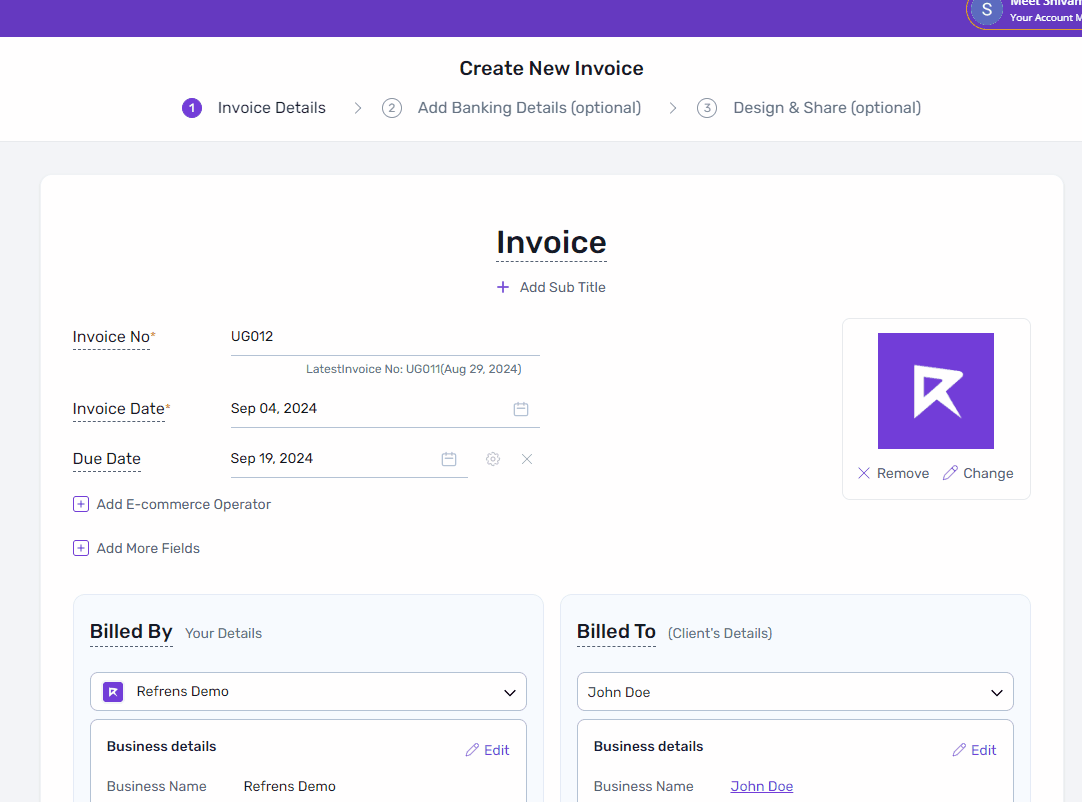Every business has its unique way of invoicing. A traditional business will charge based on the number of goods they are selling, while an Interior Designer will price their services on a per-square-foot basis, and a Content Writer will charge based on the number of words or articles they have to write.
Refrens enables you to easily customize columns & formulas according to your business requirements.
Let's see how:
Simple Columns & Formulas Customization
Watch this video to learn how to customize column names, column visibility, formulas, and more according to your business requirements:
Customizing Columns & Formulas to Include Multiple Billing Parameters
If you are charging clients based on the combinations of two different billing parameters—like time and quantity —a customized invoice with multiple quantity fields and formulas can help you provide a clearer and more detailed invoice.
Let's take an example of a wedding videographer who charges clients based on two different parameters:
Number of Hours for the video shoot.
Number of Reels produced.
In this case, the videographer needs an invoice that includes separate quantity fields to reflect both of these billing parameters accurately as shown below:

Here's a step-by-step guide on how to create such a custom invoice using custom formulas.
Step 1: Add Custom Columns for Each Billing Parameter

A) Navigate to the "Edit Columns/Formulas" section of your invoice editor.
B) Add two new columns:
No. of Hours: To capture the number of hours spent on the video shoot.
No. of Reels: To record the number of reels produced.
C) Set the column type to "Number" for both new columns. This ensures the values entered are treated as numerical data, which is crucial for calculation purposes.
Step 2: Customize the Quantity Column with a Formula
To calculate the total quantity based on the two different billing parameters, you'll need to use a formula:
A) Go to the Quantity column in your invoice editor.
B) Change the column type to "Formula". This allows you to define a custom calculation for the quantity field.
C) Once you select "Formula," you'll see column references (e.g., A1, B1, C1, D1, etc.) for each of the columns you've added.
D) Define the Formula for Quantity Calculation:
in the quantity column, you will see a formula field called “fx”.
Here, we have to define how the quality is calculated. In our case, Both 1) No. of Hours, and 2) No. of Reels both are quantities. So, for us,
Quantity = No. of Hours + No. of Reels
I.e. fx= B1+C1
Here:
- B1 represents the "No. of Hours" column.
- C1 represents the "No. of Reels" column.
This formula adds up the values from both columns, giving you a combined total in the Quantity field.
Step 3: Understand How It Works
Let’s look at an example to see how this formula will work:
As you see above,
- For the line item "Video Shoot," you would fill in the "No. of Hours" field with the number of hours spent shooting and leave the "No. of Reels" field empty.
- Conversely, for the line item "Reels," you would enter the number of reels produced in the "No. of Reels" field and leave the "No. of Hours" field empty.
By structuring your invoice this way, each line item is accurately billed based on its relevant parameters.
Step 4: Hide The Quantity Column For A Cleaner Look
To keep your invoice looking clean and professional, you might want to hide the Quantity column. For that, simply go to the Column Settings and select the option to hide the Quantity column:
This will make your invoice easier to read and ensure that only the most important information is visible to your client
Advanced Formulas
If you want to perform certain actions like rounding off the decimals, taking square roots, calculating a percentage, etc. you can do the same with advanced formulas.
Note that, you would most likely not need to use these formulas as most basic formulas are automatically calculated on Refrens. this is just for your knowledge in case you require it in exceptional cases.
A. Rounding off decimals

As you see in the above invoice. Let's say you want to keep the decimals to two only, you can do that with a custom formula like below.
First, my initial formula for calculating area was like this:
Area = Length * Width = B1*C1
But to limit this value to two decimal points only, I will rewrite the formula like below:
So, The new formula = Round((Original Fornmula),2)
This formula is for 2 decimal places. If you want to keep just 1 or 0 decimal places, you can rewrite the formula as,
For 1 decimal place : The new formula = Round((Original Fornmula),1)
For 0 decimal place: The new formula = Round((Original Fornmula),0)
After you save the formula, you will see that it will be updated in the invoice as well.
B. Taking a square root
If you want to take a square root of two values, you can do that with a function like this: Sqrt((coulmnX * columnY))
C. Getting Max value out of two values
If you want to take the maximum values of two values, you can do that with a function like this: max(columnX, columnY)
D. Calculating a percentage
If you want to find what percentage ColumnX is of ColumnY, you can use a formula like this: (ColumnX/ColumnY) * 100
